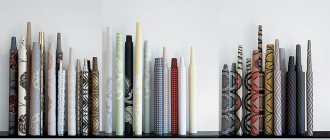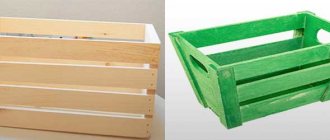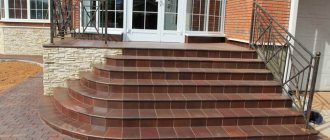At all times, wood has been considered one of the best materials. Because of this, it is often used to decorate various rooms, including residential ones.
This material is characterized by a long service life, high environmental friendliness and aesthetics.
The popularity of wood and its unique structure prompted manufacturers of finishing materials to create wooden wallpaper.
The idea turned out to be a winner, since the latter immediately attracted the attention of consumers, and homes decorated with their use began to look more original, elegant, elegant and solid.
Wallpaper made of natural wood
They are 100% wooden wallpaper. Only this material is used for their manufacture. Wallpaper made of natural wood are small thin plates no more than 20 cm wide. Their surface can be smooth or textured, with or without a pattern.
Wallpaper made of natural wood is attached to the wall using glue, and they are joined to each other using the “groove and tenon” principle.
This hidden connection allows the wood to “breathe” and maintains the integrity of the design due to the fact that the seam is completely invisible.
Application in the interior
For gluing to walls, as a rule, light products in white and beige tones are used. Only one wall is finished in order to correctly place accents in the room. In the latter case, the wallpaper should be darker compared to other walls. The panels can be used in any residential premises.
Bedroom
The ideal place for installation would be a wall located behind the bed or opposite it. The design can occupy the entire width of the wall or a small area, serving as a panel.
An original solution would be to stick wallpaper that imitates a mosaic of wooden elements. This gives the room decoration a special attractiveness and dynamism.
Coverings with natural wood patterns are suitable for any design style: classic, country, hi-tech, loft, minimalism and others. The color scheme of the decoration should be combined with the curtains, bedspreads and other elements of the room’s decoration.
Living room
Wallpaper can be mounted on any free wall that is well lit. The design of the products can be varied: imitation logs, tree bark, aged boards, images of trees and flowering branches. Panels are also used for the ceiling, which brings harmony and comfort to the room.
Kitchen
Natural wood coverings look good in the kitchen and dining area. Experts recommend using non-woven coverings that replace conventional aprons.
Wooden wallpaper in the interior is used more and more every year. Natural products look attractive, harmoniously combine with various design styles, and bring coziness and comfort. Information about the advantages and disadvantages will help you make a decision about purchasing wallpaper.
Veneer wallpaper
Veneer wallpaper is a sheet of thick paper, on one side of which a veneer of one or another type of wood is glued. Their main difference from wallpaper made from natural wood is their lower cost. But at the same time, all other indicators - durability, environmental friendliness, practicality and aesthetics - remain unchanged.
Wooden veneer wallpaper is sold in rolls from 5 to 10 m long and 35-50 cm wide. However, other sizes are possible depending on the manufacturer.
According to the method of their fastening, they are similar to ordinary paper wallpaper. The adhesive composition should be applied to the substrate, and then, joining the edges of the pattern, it is necessary to paste the walls of the room.
Question details
Texture
To achieve maximum resemblance to natural wood, it is necessary to use not just similar patterns and colors, but also a heterogeneous texture. Real wood in any form is not perfectly smooth. In imitations, manufacturers use images of birch, oak, spruce and alder wood. The surface of expensive vinyl, paper and non-woven wallpaper can exactly replicate all the irregularities, ring shapes and roughness of a natural trunk. Trendy accents are coatings that replicate the cuts and bark of exclusive wood species - wenge, robinny and merbau. It can be found in exclusive collections, and the price in this case will be unreasonably high. But you will have a unique interior.
To obtain the most realistic texture, which will be close to simplicity and nature, you should use wallpaper in a brown shade for wall decoration. but bright colors can also be reflected in different interior styles. The white coating, which has been artificially aged, will fit perfectly into the marine theme of a recreation room or living room. Provincial style will also help refresh light colors. Mahogany will be an excellent complement to baroque and classic. Pink boards placed vertically can complement a shabby chic bedroom.
Matte dark wallpaper designed to look like a log house will help give the interior a special fabulousness and romance. You will feel as if you are in an old village house, and such walls will bear the imprints of time. Interesting solutions in the interior can be found if you choose a coating with an imitation of a wooden floor. In this case, it is better to work in one color scheme, which means that if the floor is made of dark boards or glossy bright parquet, it is better to make the walls matte and in light shades. Otherwise, there will be too much color and shine, and you will very quickly get tired of this design.
Please note that the currently popular loft style is also not complete without imitation wood on the wall. For this case, the design and surface should be as similar as possible to the real thing, like boards or a log frame with a rough, rough surface.
Wood-effect wallpaper can always be combined with plastic panels. In the corridor, the lower part of the walls, which is finished with plastic panels, will make the room practical, and the upper part with imitation wood on the wallpaper will provide you with a fresh and natural design. lovers of everything original are advised to take a closer look at less common, artificial and bright shades of wood for wallpaper. A green or purple board pattern will be a great addition to an avant-garde interior. In this case, the furniture should be in calm tones and have similar colors, and also use decorative elements (curtains, pillows, panels). Cork wallpaper with its original texture will add naturalness and naturalness to the interior.
Advantages and disadvantages
Wood in the interior will give you a cozy, warm and close to nature atmosphere. If you need to save at least a little or just like to update your decor frequently, then the ideal option would be to stick to paper wallpaper. They are the cheapest, but there are many wood patterns in different colors and types. In addition, they are environmentally friendly and allow the walls to breathe. But it’s worth choosing duplex wallpaper (i.e., two-layer), as it will be denser, although a little more expensive.
Interestingly, a huge advantage for vinyl flooring is the ability to perform wet cleaning. In addition, their wood-like texture is as close as possible to the real one, and thanks to their relief and strength, small defects in the walls can be properly hidden.
To achieve maximum similarity with natural wood, you should use not just similar patterns and colors, but also a heterogeneous texture. Real wood in any form will not be perfectly smooth, and to imitate it, manufacturing companies often use images of spruce, oak, alder and birch wood. Non-woven fabric can also perfectly transfer natural patterns onto wood, but it will not be able to withstand cleaning with water and its cost is higher. A huge advantage of this type of finish is that it is environmentally friendly, so they can be safely used for bedrooms and living rooms, as well as for a children’s room.
Modern wallpaper with a photo printed on it is convenient in terms of gluing, since it is sold in the form of a single canvas, so there is no need to adjust or measure anything. In addition, the choice of patterns with wood imitation is quite large. The most commonly used images are saw cuts, woodpiles and boards. 3D wallpaper with a photo image very well conveys all the subtleties of wood texture.
Liquid wallpaper can also have a certain structure and color, and in such a way that they will not differ at all from the real thing. They are durable, environmentally friendly and elastic. Since such wallpapers are made from natural ingredients, they can be considered hypoallergenic. The great advantage of this coating is that it is soundproof and retains heat perfectly. They will also not fade due to the use of high quality components.
Important! If you need to change such a coating or restore it, you only need to remove a certain area and apply a new layer. The advantage is that there will be no visible lines or boundaries.
We should also talk about the pros and cons of natural wallpaper. A cork covering can be selected for people who have poor health, as it will not absorb dust and will not cause allergies. This material also retains heat well, is soundproof, plastic and, in combination with special impregnations, can repel moisture. Thanks to its thick layer, it can perfectly hide defects on the surface of the wall being treated.
The unique relief pattern will differ from other types of natural wood wallpaper. Lack of susceptibility to fungi and microorganisms, as well as durability, are also significant advantages, as is fire safety. But keep in mind that finishing with cork will be expensive, and if you have animals or children in your house/apartment, the coating can be damaged in a short time due to the fact that the surface is soft and pliable. Veneer has similar positive qualities as cork, but it is inexpensive and flammable (slightly more expensive than regular paper wallpaper).
Options for different rooms
To create a trendy and unique living room, you cannot do without using wood motifs. A bold solution could be a ceiling covered with dark wood boards. The walls can be any natural shades of wood. Board patterns with a coating that will be embossed will ideally emphasize protrusions or niches, but at the same time, the remaining patterns must be neutral or at least monochromatic.
Horizontally combined light and dark stylized wallpaper will look good in a room with low ceilings. Bright accents of unusual colors, for example, blue aged boards, will not leave either you or your guests indifferent. In a green interior that leans towards naturalness, a wooden motif in beige and gray shades with a matte, unobtrusive structure that will replicate the natural one will look great. But piles of large saw cuts and logs would be appropriate as an accent of rustic style.
For the bedroom, it is better not to choose glossy and flashy textures, and opt for a white shade with imitation paint or light natural shades. If you want to decorate one of the walls with wood-look wallpaper, it is better to choose the one behind the head of the bed. In this case, choose any color and pattern option, and the rest of the space can be balanced with pastel colors. But it is better that the natural theme is complemented in a similar style (stands, vases, pillows, paintings). In the kitchen, both places are suitable for decorating with wooden motifs - the wall near the table and behind the kitchen furniture. The dining area can be emphasized with photo wallpapers and boards with relief, logs or cuts of any shade. The bleached color will fit perfectly into a Scandinavian or minimalist style.
Please note that it is better to give preference to washable wallpaper, but it is better to avoid natural materials, as they can absorb odors.
But for a children's room, the choice of wood decor is not so large. Natural, not bright colors on non-woven or paper-type wallpaper will help to dilute an unobtrusive marine-themed design, as well as the use of inscriptions or decorative stickers. An interesting option in this case is imitation ship wood, which boys will appreciate. The corridor will be the ideal place to combine shades of light wood on the surface of the walls and natural wood or imitation wood on the floor. This will make it possible to bring a feeling of comfort and free space. There are two more rooms that are more typical of country houses - a library and an office. Wood motifs would be appropriate here, and this is the case when you don’t have to worry and use both dark and bright saturated colors for decoration.
Note to the consumer
Before choosing wooden wallpaper to decorate a particular room, you should keep in mind that this material, for the most part, does not tolerate moisture well. If the room is damp, then it is better to give preference to other finishing materials, since the wood will subsequently swell and become unusable. As a result, the repair will have to be done again.
In the case where humidity levels are slightly higher than normal, you can resort to decorating with wooden wallpaper. But at the same time, it is necessary to provide them with additional protection by treating their surface with varnish or wax.
You should also take into account the fact that wood is a tasty morsel for many types of insects. If a house or apartment has ever been subjected to similar attacks, then it is likely that they will return again, but this time in order to enjoy the taste of wallpaper. Before decorating the interior of your home with wooden wallpaper, you need to make sure that access to insects will be reliably blocked.
Interior ideas
In the place where there will be a dining room, an emphasis on imitation wood of a dark shade would be appropriate, as this will help bring solemnity to the atmosphere. In the bedroom, on the central wall, a color palette in pastel shades, and even the use of blue, which is unnatural for wood, will look extremely impressive. She will give lightness and tenderness.
A work corner or office will sparkle with new colors if you make the walls look like varnished boards, and also complement the interior with pieces of furniture in a vintage style. Cork wallpaper will help create a successful background for a minimalist interior, and photo wallpaper depicting a woodpile will become a fashionable discovery for the rest room. Guests will definitely appreciate this decision.
Wood wallpaper installation technology
First, you need to attach a guide fastening structure to the walls—the sheathing. It is made from boards or bars. In order for the frame to be more durable, it must be impregnated with special antifungal drugs. If necessary, you can place thermal insulation between the bars.
After you have installed the base, you can begin installing the wooden wallpaper. It is advisable to leave this wallpaper for several days to acclimatize. Do not forget that the temperature and humidity of the room where they are kept must coincide with the conditions of the room where they are planned to be installed. Wooden wallpaper should be stored horizontally.
If desired, you can lay wooden wallpaper in different directions. There is one good design trick: if you place the panels vertically, they will visually increase the height and narrow the space; if placed horizontally, they will expand the space, but the ceiling will seem lower. To make the room seem larger, you need to choose panels with small patterns. And vice versa: for rooms that are too large, panels with large patterns will be suitable, which will visually make the room smaller.
Installation of panels must begin from the corner. If you have a horizontal finish, then the panels must be laid with the groove down. The profiles must be evenly adjacent to each other.
To install wooden wallpaper, you can use clapboard nails - they are very thin and practically have no head. Using a hammer, they are driven into the groove of each board at an angle of 30 degrees. And then, with the help of a hammer, they are hammered in completely. When doing this type of work, it is very important to drive in the clapboard nails very carefully. After all, in the groove area you can split the wood. You should also use the hammer carefully so as not to hit the working surface of the wall covering.
A more modern and practical way is to use clamps. These are special metal clips. They are nailed to the sheathing and securely fix the wooden wallpaper. This fastening method makes it easier to install and dismantle the wallpaper. The dimensions of the clamps must be selected according to the thickness of the groove of the wooden wallpaper.
It is also possible to install wallpaper using so-called liquid nails. But this method is completely impractical. After all, the covering area is large, so the supporting structure must be perfectly flat. But achieving such a result is quite difficult.
The final stage of finishing is the protective decoration of the coating. To do this, you can use stains that not only tint, but also emphasize the texture of the wood. You can also use oils, waxes or varnishes. It is best to use natural and environmentally friendly products.
Advantages of wooden wallpaper compared to lining
If we compare them with lining, which preceded the appearance of wallpaper, then the latter has a number of advantages. The main ones are light weight and faster installation speed.
- Installing the lining is a rather painstaking task, in which each narrow strip is nailed separately. Wooden wallpaper for interior decoration is glued in strips, as a result of which the installation speed is significantly accelerated.
- If we talk about weight, then the lining is heavier. This is another plus in the direction of wallpaper. They can be used to decorate the ceiling, arches, niches, and decorative projections.
Wooden wallpaper for interior decoration photo
Among the disadvantages, it should be noted that the lining is more natural than wooden wallpaper. Still, the latter are in some way a composite material, and chemical impregnation and adhesive compositions do not add naturalness. The lining can consist exclusively of wood without any impregnation, i.e. safety for human health is guaranteed 100%. In addition, one of the disadvantages that should be noted is the fact that in damp rooms the joints and edges of wooden wallpaper can peel off.
Features of wooden wallpaper
The average length of wooden wallpaper panels is 2.5-6 m. But the thickness can be either 12.5 mm (for exterior decoration) or 18 mm (for exterior work). Working width - 88 and 112 mm. Most often, wooden wallpaper is sold in packs of 10 pieces. These packs are packed in shrink film.
Wooden wallpaper can be divided into several categories:
— “extra” category — there are not the slightest knots or other defects on the surface of the panels;
- category "A" - there may be a small number of knots on the surface;
- category "B" - there are quite a lot of knots on the front surface of the wallpaper.
Black knots are not allowed on the surface of wooden wallpaper (they are also called “dead” knots, which appear during the installation of materials.
Advantages
Wooden interior decoration is popular. “Living” natural material inspires the creation of ever new types of it. The main advantages of veneer and cork wallpaper:
- versatility, aesthetics;
- helps to create various interiors: from minimalist to the most sophisticated;
- a wide selection of colors and textures: you can choose ones with natural patterns, stylized like mosaics, stone, leather, frescoes;
- good thermal insulation qualities: wooden wallpaper does not interfere with air exchange, keeps cool for a long time in hot weather, retains heat in cold weather;
- good sound insulation: professional music studios and cinemas are covered with cork panels, protecting the apartment from annoying noise from neighboring rooms;
- environmental friendliness: rooms decorated with wood are easy to breathe, unpleasant odors do not linger in them, people are less likely to suffer from allergies.
With proper use, wood wallpaper can last up to 20 years.
Flaws
In addition to the fragility and swelling that classic veneered wallpaper is subject to, this type of finish has several more significant disadvantages:
- complexity of installation: it is unlikely that you will be able to successfully cover the walls with them alone; it is more productive to invite craftsmen;
- low biostability: bugs attracted by the smell of wood can settle in the pores of the wallpaper; species not treated with special impregnations are susceptible to fungal infections;
- high cost: the price of veneer wallpaper starts from 2,000 rubles per roll; materials made from oak cork can cost 5,000–11,000 rubles per package.
The durability of most wood-containing finishing materials is considered both an advantage and a disadvantage . Interior owners are annoyed by the need for early dismantling, for example, during a major renovation or a decision to change the style of the room. Reusing removed wallpaper is no longer possible. Before purchasing an expensive finish, it is better to carefully weigh all the possible risks and possible changes.
Installation Tips
The technique of pasting walls with wooden wallpaper differs little from working with similar finishing materials from other raw materials.
Before finishing, it is recommended to unpack the rolls and leave them indoors for 2-3 days so that they get used to its microclimate.
For the work you will need plumb lines and brushes. If you plan to finish with roll materials, you need a rubber roller to smooth the canvases. Before starting work, the walls must be leveled, cracks and chips repaired, puttied, and a primer applied.
Cork panels can be attached to liquid nails and other special compositions for slabs . The same adhesive that is used for vinyl wallpaper is well suited for rolled wooden materials.
The strips are measured and cut in advance, adding 2–3 cm in height . First, a section of the wall is covered with glue, then an even thin layer is applied to the inside of the wallpaper. Some types of cork are produced with an already applied adhesive layer. This greatly simplifies installation: you need to remove the protective film from the back side and attach the section to a section of the wall. A convenient innovation for fastening is metal clamps. These are thin clips used instead of glue if the walls are uneven. The wallpaper is attached dry and very quickly.
When gluing veneered wallpaper with a pattern, care must be taken to ensure that all its elements match. Particular attention should be paid to the processing of edges: if impregnation is insufficient, they may peel off.
The finishing of walls with panels usually begins with the central areas of the rooms. Rolled cuts are measured from the corner. Thanks to its high density, wooden wallpaper is quite easy to glue: it rarely forms wrinkles and bubbles, immediately adheres to the wall, and is easily smoothed out.











